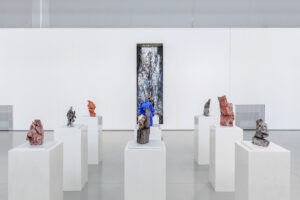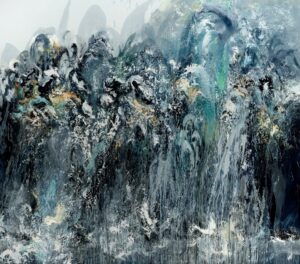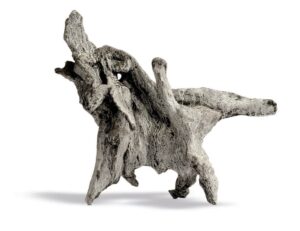Acclaimed as much as contested British artist with an important career, Maggi Hambling is the protagonist at the Ettore Fico Museum in Turin of the ‘On The Edge’ solo show, a rather explanatory exhibition of her work with clear references to the Japanese art by Hokusai and abstractionism. Meeting her at the opening of the exhibition during the Art Week was both exciting and instructive. Hambling glows with a seemingly standoffish aura and approaches others with a decisive attitude, but in fact in all public speeches, as well as in interviews, she is completely at ease and even endowed with an enviable sense of humour.

Maggi Hambling, On the Edge, installation view at MEF Museo Ettore Fico, photo Beppe Giardino, courtesy MEF Museo Ettore Fico
She is an artist who is not categorised, she herself declares that she does not want to be pigeonholed into any artistic movement whatsoever, and approaches sculpture and painting with deep cultural references. Educated in England in the 1960s, a friend of Francis Bacon and Lucian Freud, she has always been in favour of pacifist causes, even participating in Woodstock, and has often exhibited in her long career siding with feminist causes, not always with unanimous recognition. Fascinated by Oscar Wilde at a very young age, she completed the reading of his complete works at the age of twelve and then, as an established artist, came to the creation of ‘A Conversation with Oscar Wilde’, a green granite sarcophagus from which emerges a bronze bust holding a cigarette. It is a celebratory sculpture that recalls her appearance and also her lifelong close association with smoking. She slyly seems to share David Hockney’s interpretation that smoking affects, more mental health than physical health, and in fact she does not willingly part with her beloved cigarette that has given her a rough, warm voice over the years.

Maggi Hambling, Wall of Water V, 2011, oil paint on canvas, 198 x 226 cm, courtesy Thomas Brambilla Gallery
Actually, smoking often returns in her works, both in the one inspired by Oscar Wilde, and in the paintings of the ‘Edge’ series characterised by material brushstrokes with colours in shades of greys and dusty blues, which in the darkest variants may suggest untamed smoke clouds. If one seeks solace in interpreting the subject of one of her paintings, it nimbly sidesteps an intelligible explanation, reminding the interlocutor that the economy of lines that seems to be glimpsed in her work is entirely random. She confesses that she instinctively paints what she feels inside and this stems from the way she lays colour on the canvas, simply allowing the truth to emerge. The works from the ‘Edge’ series are also reminiscent in some respects of untamed waves of the stormy sea, and the sea is an inescapable form of inspiration that appears in both her paintings and sculptures.

Maggi Hambling, Aftermath (Baby Elephant), 2014, bronze primed and hand coloured, 31 x 37 x 14 cm, courtesy Thomas Brambilla Gallery
On the beach in Aldeburgh, Suffolk, where Hambling lives, the artist created ‘Scallop’, an imposing sculpture more than four metres high in memory of the composer Benjamin Britten. Despite the fact that this sculpture was also the subject of much criticism at home, the marine element that distinguishes it also returns in the sculptures presented in the exhibition. In this case, in fact, a number of bronze sculptures are exhibited, subsequently plastered and painted, whose forms are inspired by woods found on the beach that, although characterised by random shapes produced by erosion and time, gives to the works a truly intense significance. The soft, lubricious colours of the sculptures, with a few exceptions for salmon pinks perfectly suited to the works to which they refer, bring these objects back to life, bringing out the abstractness and hidden spirituality in them.
Info:
Maggi Hambling. On the Edge
a cura di Andrea Busto
28/09/2023 – 17/12/2023
MEF Museo Ettore Fico
Via Francesco Cigna, 114, 10155 Torino
www.museofico.it

Globetrotter, passionate about literature, lover of art and photography. I never leave for a trip without taking with me a book by an author of the place where I will go. I have dreamed of moving to Paris for years and sooner or later I will!






NO COMMENT